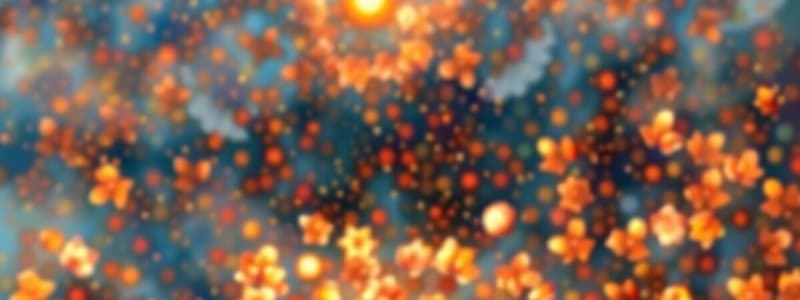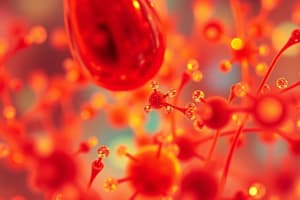Podcast
Questions and Answers
What is the primary function of a light microscope?
What is the primary function of a light microscope?
- To view and magnify small objects using sound waves.
- To examine live cells without any staining.
- To view, discover, and magnify small objects using visible light. (correct)
- To utilize infrared light for imaging unstained samples.
What is one limitation of Brightfield microscopy?
What is one limitation of Brightfield microscopy?
- It cannot image thick tissue or multiple optical sections. (correct)
- It can image thick tissue with high resolution.
- It provides high contrast for all types of samples.
- It allows live cells to be counterstained easily.
Which component is essential for Differential Interference Contrast (DIC) microscopy?
Which component is essential for Differential Interference Contrast (DIC) microscopy?
- Halogen bulb for illumination.
- Centrifuge for sample preparation.
- Polarizers and a compensator. (correct)
- Incubator for live cell observations.
What does Phase Contrast microscopy enhance in unstained samples?
What does Phase Contrast microscopy enhance in unstained samples?
What occurs during the process of birefringence in Polarized Light microscopy?
What occurs during the process of birefringence in Polarized Light microscopy?
In Darkfield microscopy, how are bright specimens depicted?
In Darkfield microscopy, how are bright specimens depicted?
What type of light is primarily used in Brightfield microscopy?
What type of light is primarily used in Brightfield microscopy?
What is a key feature of Differential Interference Contrast (DIC) microscopy?
What is a key feature of Differential Interference Contrast (DIC) microscopy?
What is the effect of using a closed condenser aperture in microscopy?
What is the effect of using a closed condenser aperture in microscopy?
How does numerical aperture (NA) influence image quality in microscopy?
How does numerical aperture (NA) influence image quality in microscopy?
Which factor significantly affects the resolution capability in microscopy?
Which factor significantly affects the resolution capability in microscopy?
Why is proper sample thickness important in microscopy?
Why is proper sample thickness important in microscopy?
What role does the lookup table (LUT) play in digital imaging?
What role does the lookup table (LUT) play in digital imaging?
What is a key difference between CCD and CMOS cameras in terms of imaging?
What is a key difference between CCD and CMOS cameras in terms of imaging?
What is the significance of using fresh frozen tissue in microscopy preparation?
What is the significance of using fresh frozen tissue in microscopy preparation?
Which component is crucial for aligning the light path in microscopy to achieve full field illumination?
Which component is crucial for aligning the light path in microscopy to achieve full field illumination?
Flashcards
What is Light Microscopy?
What is Light Microscopy?
A type of microscopy that uses visible light to illuminate and magnify small objects, revealing their structure and details.
What wavelengths of light are used in light microscopy?
What wavelengths of light are used in light microscopy?
The wavelengths of light used in light microscopy range from ultraviolet (200 nm) to near-infrared (700 nm), covering the visible spectrum.
What is the role of the light source in a brightfield microscope?
What is the role of the light source in a brightfield microscope?
A component of a brightfield microscope that produces a bright, focused beam of light directed at the specimen.
What type of specimens are typically used in brightfield microscopy?
What type of specimens are typically used in brightfield microscopy?
Signup and view all the flashcards
What is the principle of Differential Interference Contrast (DIC) Microscopy?
What is the principle of Differential Interference Contrast (DIC) Microscopy?
Signup and view all the flashcards
What is the principle of Phase Contrast Microscopy?
What is the principle of Phase Contrast Microscopy?
Signup and view all the flashcards
What is the principle of Polarized Light Microscopy?
What is the principle of Polarized Light Microscopy?
Signup and view all the flashcards
What is the principle of Darkfield Microscopy?
What is the principle of Darkfield Microscopy?
Signup and view all the flashcards
Resolution in Microscopy
Resolution in Microscopy
Signup and view all the flashcards
Numerical Aperture (NA)
Numerical Aperture (NA)
Signup and view all the flashcards
Lookup Table (LUT)
Lookup Table (LUT)
Signup and view all the flashcards
Magnification
Magnification
Signup and view all the flashcards
Refractive Index
Refractive Index
Signup and view all the flashcards
Camera Types and Imaging
Camera Types and Imaging
Signup and view all the flashcards
Bit Depth
Bit Depth
Signup and view all the flashcards
Condenser Aperture Diaphragm
Condenser Aperture Diaphragm
Signup and view all the flashcards
Study Notes
Light Microscopy
- Uses visible light to magnify small objects
- White light spans the UV range (~200nm) to near-infrared (~700nm)
Brightfield Microscopy Components
- Light source (typically a halogen bulb)
- Condenser focuses light on the specimen
- Specimen (usually stained tissue or cells)
- Transmitted light is focused to produce the image
Brightfield Imaging Modalities
- Brightfield Imaging: Uses white light to illuminate a specimen, highlighting areas with high contrast
- Applications: Diagnosing disease states from patient samples, long-term imaging.
- Limitations: Unable to image thick tissue or multiple sections. Dye toxicity prevents live cell imaging.
Alternative Imaging Techniques
- Differential Interference Contrast (DIC): Enhances contrast for unstained samples (e.g., cells, nematodes, bacteria.) Requires polarizers and a compensator.
- Phase Contrast Microscopy: Enhances contrast in low contrast/unstained samples, particularly useful for thinner samples. Requires a condenser annulus and a phase plate.
- Polarized Light Microscopy: Uses two polarizers, useful for birefringent specimens.
Darkfield Microscopy
- Contrasts bright specimens against a dark background
- Only oblique (angled) light rays illuminate the specimen
- Scattered light creates bright images
Sample Preparation Considerations
- Some techniques require fixation
- Tissue preparation (e.g., cutting frozen tissue with a cryo microtome or vibra-tone) needs to adjust thickness to ensure adequate light transmission
- Proper labeling and staining are critical
Image Acquisition Optimization
- Correct alignment of light sources is vital to avoid glare and uneven illumination
- Adjusting objective settings and conjugate planes within the light path enhances resolution and field illumination.
- Correctly using condenser and field diaphragms
Color Illumination
- Aperture in the condenser affects image quality and detail visibility
- Open aperture produces glare and refraction artifacts
- Closed aperture decreases the amount of light, reducing visibility of details
Numerical Aperture (NA)
- Determines the resolving power (clarity) of the objective lens
- Takes into account refractive index and light cone angle
- Higher NA= more light captured = better image signal
Refractive Index
- Measures light bending between different media
- Denser materials (e.g., water, glycerin) increase NA.
- Crucial understanding image resolution
Resolution in Microscopy
- Ability to differentiate points that are close together
- Directly related to numerical aperture
- Higher resolution allows for clearer zooming and more detailed viewing
Camera Types and Imaging
- CCD cameras yield low-noise, high-quality images, while CMOS operate more quickly
- Cameras convert photons into digital images through pixels
Digital Image Quality
- Megapixels and bit depth influence image quality
- Higher megapixels mean better image resolution, while bit depth impacts tone variation (shades of gray)
Magnification
- Process of enlarging an object's apparent size in microscopy
- Calculated by multiplying objective and eyepiece magnification
Lookup Table (LUT)
- Represents pixel intensity distribution in a digital image
- Essential for visualizing and interpreting image data
Dynamic Range and Lookup Tables
- Crucial for capturing maximum image information
- Aids in visualizing image details and maximum dynamic range
Over and Under Saturation
- Saturation refers to pixel intensity values in images
- Good images exhibit fewer over/under-saturated pixels
- Excessively saturated or unsaturated images introduce errors in data analysis
Image Comparison
- Analyzing images with varying saturation settings helps determine optimal imaging conditions
- Examples demonstrating the impact of excessive color casts
White Balancing
- Corrects color casts in images to accurately reflect the sample's true colors
- Accounts for variations in light source colors
Exposure Time
- Impacts pixel saturation and image visibility
- Affects details with low and high exposure times; optimal exposure results in clear details; excessive exposure can lead to glare and indistinct structures
Studying That Suits You
Use AI to generate personalized quizzes and flashcards to suit your learning preferences.




